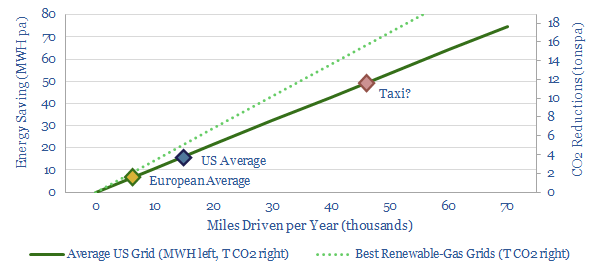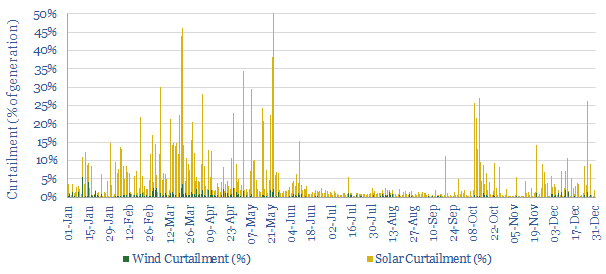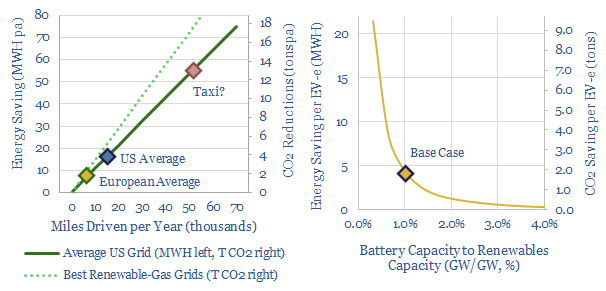Who will ‘win’ the intensifying competition for finite lithium ion batteries, in a world that is hindered by shortages of lithium, graphite, nickel and cobalt in 2022-25?
Today’s note argues EVs should outcompete grid storage, as the 65kWh battery in a typical EV saves 2-4x more energy and 25-150% more CO2 each year than a comparably sized grid battery.
Competitor #1: Electrification of Transport?
The energy credentials of electric vehicles are laid out in the data-files below. A key finding is their higher efficiency, at 70-80% wagon-to-wheel, where an ICE might only achieve 15-20%. Therefore, energy is saved when an ICE is replaced by an EV. And CO2 is saved by extension, although the precise amount depends on the ‘power source’ for the EV.
When we interrogate our models, the single best use we can find for a 65kWh lithium ion battery is to electrify a taxi that drives 20,000-70,000 miles per year. This is a direct linear pass-through of these vehicles’ high annual mileage, with taxis in New York apparently reaching the upper end of this range. Thus the higher efficiency of EVs (vs ICEs) saves 20-75MWH of energy and 7-25 tons of CO2 pa.

More broadly, there are 1.2bn cars to ‘electrify’ in the world, where the energy and CO2 savings are also a linear function of miles driven, but because ordinary people have their cars parked around 97% of the time, the savings will usually be 10-20MWH per vehicle pa.
(Relatedly, an interesting debate is whether buying a ‘second car’ that is electric is unintentionally hindering energy transition, if that car actually ends up under-utilized while consuming scarce LIBs, which could be put to better use elsewhere. As always, context matters).
Competitor #2: Grid-Scale Batteries?
The other main use case for lithium ion batteries is grid-scale storage, where the energy-saving prize is preventing the curtailment of intermittent wind and solar resources. As an example, curtailment rates ran at c5% in California in 2021 (data below).
The curtailment point is crucial. There might be economic or geopolitical reasons for storing renewables at midday and re-releasing the energy at 7pm in the evening, as explored in the note below. But if routing X renewable MWH into batteries at midday (and thus away from the grid) simply results in X MWH more fossil energy generation at midday instead of X MWH of fossil energy generation at 7pm, then no fossil energy reductions have actually been achieved. In order for batteries to reduce fossil energy generation, they must result in more overall renewable dispatch, or in other words, they must prevent curtailment.
There are all kinds of complexities in modelling the ‘energy savings’ here. How often does a battery charge-discharge? What percent of these charge-discharge cycles genuinely prevent curtailment? What proportion of curtailment can actually be avoided in practice with batteries? What round-trip efficiency on the battery?
To spell this out, imagine a perfect, Utopian energy system, where every day, the sun shone evenly, and grid demand was exactly the same. Every day from 10am to 2pm, the grid is over-saturated with solar energy, and it is necessary to curtail the exact same amount of renewables. In this perfect Utopian world, you could install a battery, to store the excess solar instead of curtailing it. Then you could re-release the energy from the battery just after sunset. All good. But the real world is not like this. There is enormous second-by-second, minute-by-minute, hour-by-hour, day-by-day volatility (data below).
Thus look back at the curtailment chart below. If you built a battery that could absorb 0.3% of the grid’s entire installed renewable generation capacity throughout the day, then yes, you would get to charge and discharge it every day to prevent curtailment. But you would only be avoiding about 10% of the total curtailment in the system.

Conversely, if you built a battery that could absorb 30% of the installed renewable generation capacity throughout the day, you could prevent about 99% of the curtailment, but you would only get to use this battery fully to prevent curtailment on about 5 days per year. This latter scenario would absorb a lot of LIBs, without unleashing materially more energy or displacing very much fossil fuel at all.
This is all explored in more detail in our detailed modelling work (data file here, notes below). But we think an “energy optimized” middle ground might be to build 1MW of battery storage for every 100MW of renewables capacity. For the remainder, we would prefer other solutions such as demand-shifting and long-distance transmission networks.
Thus, as a base case, we think a 16kW battery (about the same size as in an EV) at a 1.6MW solar project might save 5MWH of energy that would otherwise have been curtailed, abating 2T of CO2e. So generally, we think a typical EV is going save about 2-4x more energy per than a similarly-sized grid-battery.
Another nice case study on solar-battery integration is given here, for anyone who wants to go into the numbers. In this example, the battery is quite heavily over-sized.
Other considerations: substitution and economics?
Substitution potential? Another consideration is that an EV battery with the right power electronics can double as a grid-scale storage device (note below), absorbing excess renewables to prevent curtailment. But batteries affixed to a wall or on a concrete pad cannot usually double as a battery for a mobile vehicle, for obvious reasons.
Economic potential? We think OEMs producing c$70-100k electric vehicles will resist shutting entire production lines if their lithium input costs rise from $600 to $3k per vehicle. They will simply pass it on to the consumer. We are already seeing vehicle costs inflating for this reason, while consumers of ‘luxury products’ may not be overly price sensitive. By contrast, utility-scale customers are more likely to push back grid scale storage projects, as this is less mission critical, and likely to be more price-sensitive.
Overall, we think the competition for scarce materials is set to intensify as the world is going to be ‘short’ of lithium, graphite, nickel in 2022-25 (notes below). This is going to create an explosive competition for scarce resources. The entire contracting strategies of resource-consuming companies could change as a consequence…

